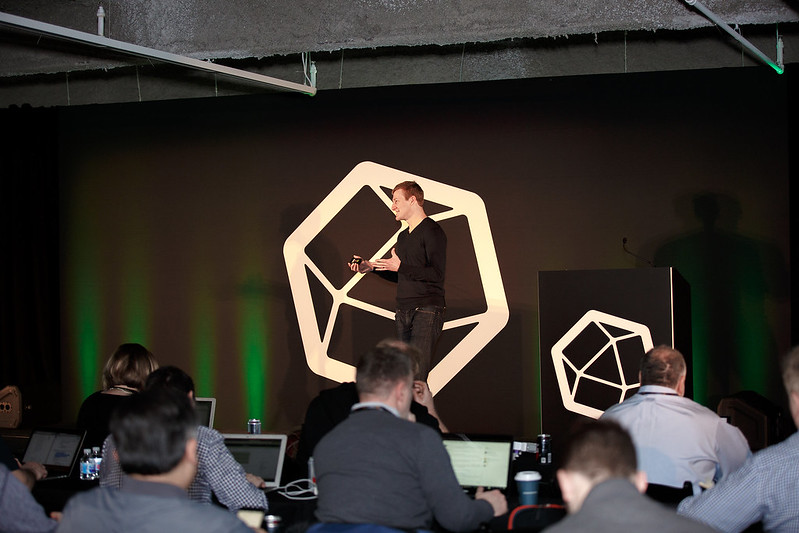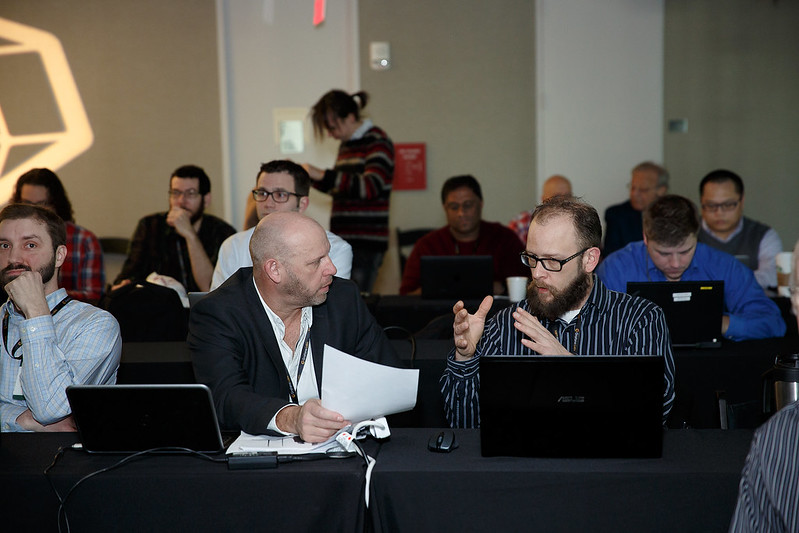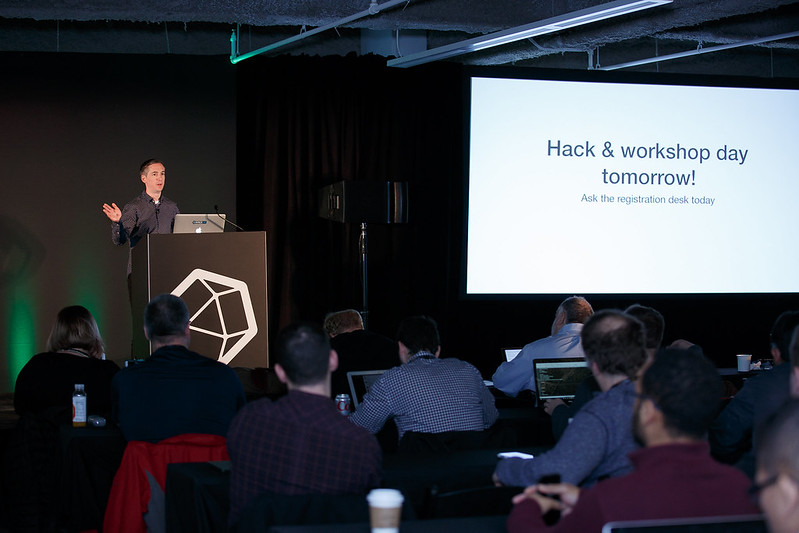
February 13, 2018 | NEW YORK
FLICKR GALLERY
NEW YORK INFLUXDAYS SCHEDULE
| 8:00 am – 9:00 am | Registration | |
| 9:00 am – 9:15 am | Welcome | Evan Kaplan, CEO | InfluxData |
| 9:15 am – 9:50 am | View from the CTO
Paul will outline his vision around the platform and give the latest updates on IFQL (a new query language), the decoupling of query and storage, the impact of hybrid cloud environments on architecture, cardinality, and discuss the technical directions of the platform. This talk will walk through the vision and architecture with demonstrations of working prototypes of the projects. |
Paul Dix, CTO | InfluxData |
| 9:50 am – 9:55 am | Q&A | |
| 9:55 am – 10:30 am | From a Time-Series Database to a Key Operational Technology for the Enterprise
It is important for a time-series database to provide efficient storage, aggregation, and query of time-series data. Elevating a time-series database to a core operational technology of the enterprise, however, involves so much more. In this talk, I will explore important considerations that take a time-series database from being just another data-store, to a critical infrastructure for operational intelligence. I will explore challenges related to time, change management, incorporating asset models from the business domain, and integration with other operational technologies, like streaming-data platforms. |
Colin Breck, Staff Software Engineer | Tesla |
| 10:30 am – 10:35 am | Q&A | |
| 10:35 am – 11:00 am | Networking break | |
| 11:00 am – 11:35 am | InfluxDB Internals
Ryan will expand on his popular blog series and drill down into the internals of the database. Ryan will discuss optimizing query performance, best indexing schemes, how to manage clustering (including meta and data nodes), the impact of IFQL on the database, the impact of cardinality on performance, TSI, and other internals that will help you architect better solutions around InfluxDB. |
Ryan Betts, Director of Engineering | InfluxData |
| 11:35 am – 11:40 am | Q&A | |
| 11:40 am – 12:15 pm | The RED Method: How to Instrument Your Services
The RED Method defines three key metrics you should measure for every microservice in your architecture; inspired by the USE Method from Brendan Gregg, it gives developers a template for instrumenting their services and building dashboards in a consistent, repeatable fashion. |
Tom Wilkie, Founder | Kausal |
| 12:15 pm – 12:20 pm | Q&A | |
| 12:20 pm – 1:10 pm | Lunch | |
| 1:10 pm – 1:45 pm | Turning Cloud Metrics into Results
You have discovered InfluxDB and now have a plethora of metrics at your fingertips. Next you want to apply these metrics and generate impactful, tangible business results. But where do you start? This talk will describe how Comcast was able to apply our multi-tenant cloud metrics to identify huge opportunities, partner with the business, and drive outcomes that include reliable cloud performance and the return of real dollars to the business…not to mention happy customers! The mission of my team is simple – remove the infrastructure-heavy lifting from our development teams and enable them a frictionless experience to deploy their applications. Over the years we have delivered IaaS and SDS, and we are now focused on Cloud Foundry PaaS (Pivotal & Open Source CF), Kubernetes, and other “above the value line” services for Comcast. Our platforms host thousands of unique applications, tens of thousands of virtual machines and containers, dozens of petabytes of storage and an expanding portfolio of homegrown telemetry and automation. To our internal customers we are a direct competitor to the top public cloud providers. |
Rob Frohnapfel, Director | Comcast |
| 1:45 pm – 1:50 pm | Q&A | |
| 1:50 pm – 2:25 pm | Data Collection & Prometheus Scraping with Sensu 2.0
Applications are complex systems. Their many moving parts, component and dependency services, may span any number of infrastructure technologies and platforms, from bare metal to serverless. As the number of services increases, teams responsible for them will naturally develop their own preferences, such as how they instrument their code or how and when they receive alerts.Sean will demonstrate how Sensu 2.0 is designed to collect monitoring and telemetry data from these heterogeneous environments and store them in InfluxDB. Sensu 2.0 is the next release of the open source monitoring framework, rewritten in Go, with new capabilities and reduced operational overhead. Using Sensu alongside InfluxDB, Sean will go over various patterns of data collection, including scraping Prometheus metrics, and show how Sensu enables self-service data collection for service owners. |
Sean Porter, Co-founder and CTO | Sensu |
| 2:25 pm – 2:30 pm | Q&A | |
| 2:30 pm – 2:45 pm | Networking break | |
| 2:45 pm – 3:20 pm | Kapacitor Stream Processing
Kapacitor is the brains of the TICK Stack. Nathaniel will cover the stream processing capabilities of Kapacitor, how to process data before it gets stored in InfluxDB and after it is stored, best practices around anomaly detection and machine learning. In addition, Nathaniel will discuss how to configure the clustered version of Kapacitor. |
Nathaniel Cook, Software Engineer | InfluxData |
| 3:20 pm – 3:25 pm | Q&A | |
| 3:25 pm – 4:00 pm | Why You Definitely Don’t Want to Build Your Own Time Series Database
At Outlyer, an infrastructure monitoring tool, we had to build our own TSDB back in 2015 to support our service. 2 years later, we decided to take a different direction after seeing for ourselves how hard it is to build and scale a TSDB. This talk will review our journey, the challenges we hit trying to scale a TSDB for large customers and hopefully talk some people out of trying to build one themselves because it is not easy! |
David Cromberge, Senior Backend Developer | Outlyer |
| 4:00 pm – 4:05 pm | Q&A | |
| 4:05 pm – 4:40 pm | What Does Kubernetes Look Like?: Performance Monitoring & Visualization with Grafana
Monitoring Kubernetes is vital to understanding the health and performance of a cluster, but which metrics are most important to add to your dashboards and alert on? Jacob will discuss how to most effectively monitor and visualize your Kubernetes cluster using the Grafana Kubernetes plugin and PromQL. Some of the topics of discussion include(1) how and what to collect when monitoring Kubernetes, (2) how to bring your Grafana dashboards to the next level by using Kubernetes as a data-source, and (3) what to do when managing multiple clusters. All of these topics and more will be discussed to help people get the most out of their Kubernetes monitoring. |
Jacob Lisi, Software Engineer | Grafana Labs |
| 4:40 pm – 4:45 pm | Q&A | |
| 4:45 pm – 5:00 pm | Closing | Paul Dix, CTO | InfluxData |
| 5:00 pm – 6:00 pm | Networking cocktails |
| 8:00 am – 9:00 am | Breakfast | |
| Getting Started | Deeper Dive | |
| 9:00 am – 9:50 am | Installing the TICK Stack and Your First Query Katy Farmer | InfluxData This session assumes that you are new to the TICK Stack and looking at how to get started. Bring your laptop, we will have the Internet connection! Download the TICK stack, get it up and running, load your first data and produce interesting graphs, alerts and notifications to Slack all by the end of the session. |
InfluxDB Functional Query Language (IFQL) Paul Dix | InfluxData In this workshop, Paul will dig deeper into IFQL providing you with some insight into how he decided to take this path and what this means for the future of your InfluxDB databases. |
| 9:50 am – 10:00 am | Q&A | Q&A |
| 10:00 am – 10:50 am | Chronograf and Dashboarding Margo Schaedel | InfluxData This hands-on session will explore the Chronograf project. Chronograf is the user interface component of the TICK Stack. You will learn on how to set up Chronograf, building your first set of dashboards, creating TICK scripts, setting alerts, and finally how to monitor and manage your InfluxData installation. Finally a brief overview of how to set up multi-user Chronograf will be discussed. |
Writing a Telegraf Plugin (Go Required) Noah Crowley | InfluxData In this session, Noah will provide you with the steps on how to write your own Telelgraf plugin. This will require an understanding of the Go programming language. |
| 10:50 am – 11:20 am | Networking break | |
| 11:20 am – 12:10 pm | Writing Queries (InfluxQL and TICK) Katy Farmer | InfluxData This session will help you write your first queries using InfluxQL. Katy will then share best practices to help make your queries efficient and fast. |
Using InfluxDB for OpenTracing Chris Goller | InfluxData OpenTracing is starting to gain traction with many applications but what is the right approach to implementing OpenTracing within your app? Chris Goller will discuss how you can best tackle the use of this technology to find issues that can be solved to keep your applications performant. |
| 12:10 pm – 1:10 pm | Lunch | |
| 1:10 pm – 2:00 pm | Architecting InfluxEnterprise for Success Ed Bernier | InfluxData In this session, you will learn how to architect your InfluxEnterprise clusters to be performant and resilient whether in a single data center or spread across multiple datacenters. |
Advanced Kapacitor Michael DeSa | InfluxData Michael DeSa will go over some of the advanced topics in Kapacitor such as joins, templated tasks, and debugging your tasks. Prerequisite: Intro To Kapacitor. |
| 2:00 pm – 2:10 pm | Break | |
| 2:10 pm – 3:00 pm | Optimizing the TICK Stack Dave Patton | InfluxData In this session you will learn how to tune your queries for performance plus strategies for effective schema design. |
Setting up InfluxData for IoT David Simmons | InfluxData David will be walking you through a typical data architecture for an IoT device. Then, it will be a hands-on workshop to gather data from the device, display it on a dashboard and trigger alerts based on thresholds that you set. |
| 3:00 pm – 3:10 pm | Q&A | Q&A |
| 3:10 pm – 4:00 pm | Downsampling Data Michael DeSa | InfluxData In this session, you will learn downsampling strategies and techniques for your InfluxDB data. |
A True Story About Database Orchestration Gianluca Arbezzano | InfluxData During this talk, Gianluca will share the architecture of the project, describe the criticalities of the infrastructure and how the team strives to make this powerful service secure, fast, and reliable for all customers using InfluxCloud. |
| 4:00 pm – 6:00 pm | Beer/Pizza |






